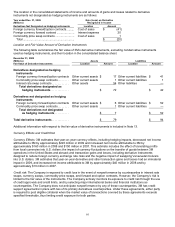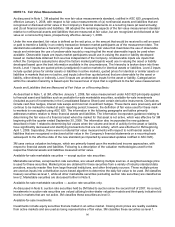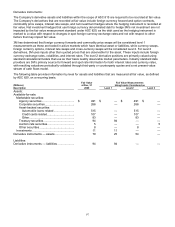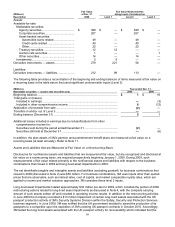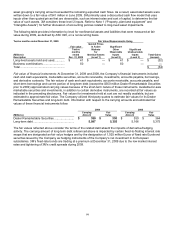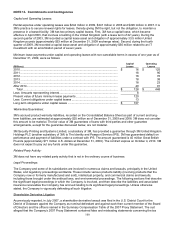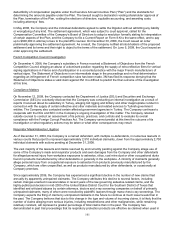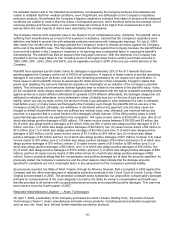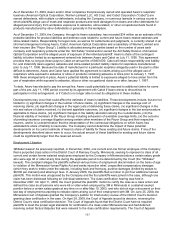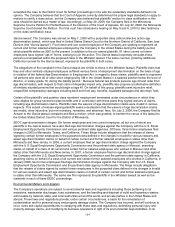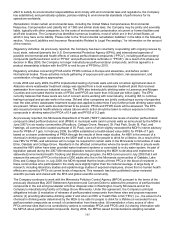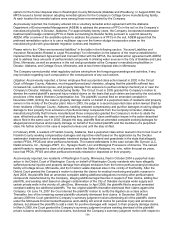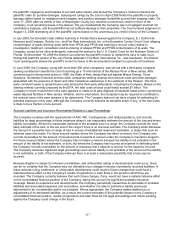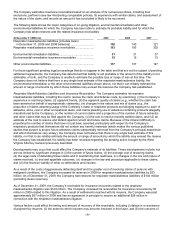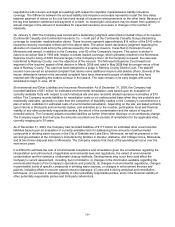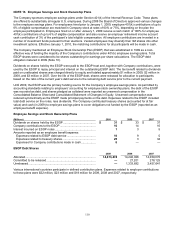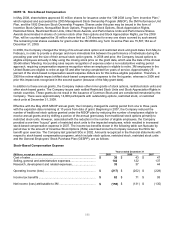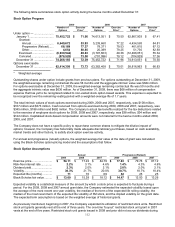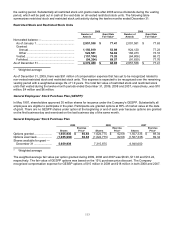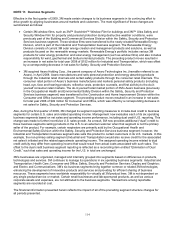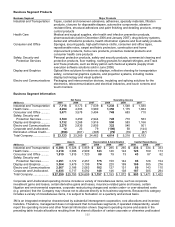3M 2009 Annual Report Download - page 111
Download and view the complete annual report
Please find page 111 of the 2009 3M annual report below. You can navigate through the pages in the report by either clicking on the pages listed below, or by using the keyword search tool below to find specific information within the annual report. 105
effort to satisfy its environmental responsibilities and comply with environmental laws and regulations, the Company
has established, and periodically updates, policies relating to environmental standards of performance for its
operations worldwide.
Remediation: Under certain environmental laws, including the United States Comprehensive Environmental
Response, Compensation and Liability Act of 1980 and similar state laws, the Company may be jointly and severally
liable, typically with other companies, for the costs of environmental contamination at current or former facilities and
at off-site locations. The Company has identified numerous locations, most of which are in the United States, at
which it may have some liability. Please refer to the “Environmental remediation liabilities” in the table in the following
section, “Accrued Liabilities and Insurance Receivables Related to Legal Proceedings,” for information on the amount
of the reserve.
Regulatory Activities: As previously reported, the Company has been voluntarily cooperating with ongoing reviews by
local, state, national (primarily the U.S. Environmental Protection Agency (EPA)), and international agencies of
possible environmental and health effects of various perfluorinated compounds (“PFCs”), including perfluorooctanyl
compounds (perflurooctanoic acid or “PFOA” and perfluorooctane sulfonate or “PFOS”). As a result of its phase-out
decision in May 2000, the Company no longer manufactures perfluorooctanyl compounds, and has agreed to a
product stewardship initiative with the EPA to end its use of PFOA by 2015.
Regulatory activities concerning PFOA and/or PFOS continue in Europe and elsewhere, and before certain
international bodies. These activities include gathering of exposure and use information, risk assessment, and
consideration of regulatory approaches.
In late 2008 and early 2009, the EPA implemented testing of private wells and soils at certain agricultural sites in
Alabama where wastewater treatment sludge was applied from a local wastewater treatment plant that received
wastewater from numerous industrial sources. The EPA also tested public drinking water in Lawrence and Morgan
Counties and concluded that the levels of PFOA and PFOS are lower than 0.04 part per billion (ppb). The EPA
currently believes that these levels are not of concern and is working with local industry, including 3M, to continue
testing municipal and private wells in the area. 3M and other companies are jointly conducting a survey of properties
near the sites where wastewater treatment sludge was applied to determine if any further private drinking water wells
are present. Where such wells are determined to be present, PFOA and PFOS levels will be assessed. The EPA
also issued provisional health advisory values (above which action should be taken to reduce exposure to these
compounds in drinking water) for PFOA of 0.4 ppb and PFOS of 0.2 ppb.
As previously reported, the Minnesota Department of Health (“MDH”) detected low levels of another perfluorinated
compound called perfluorobutanoic acid (PFBA) in municipal wells (and in private wells as announced by the MDH in
June 2007) in six nearby communities (Woodbury, Cottage Grove, Newport, St. Paul Park, South St. Paul, and
Hastings, all communities located southeast of St. Paul), some of which slightly exceeded the MDH’s interim advisory
level for PFBA of 1 ppb. In February 2008, the MDH established a health-based value (HBV) for PFBA of 7 ppb
based on a clearer understanding of PFBA through the results of three major studies. An HBV is the amount of a
chemical in drinking water considered by the MDH staff to be safe for people to drink for a lifetime. As a result of this
new HBV for PFBA, well advisories will no longer be required for certain wells in the Minnesota communities of Lake
Elmo, Oakdale and Cottage Grove. Residents in the affected communities where the levels of PFBA in private wells
exceed the HBV either have been provided water treatment systems or connected to a city water system. As part of
legislation passed during the 2007 Minnesota legislative session directing the MDH to develop and implement a
statewide Environmental Health Tracking and Biomonitoring program, the MDH announced in July 2008 that it will
measure the amount of PFCs in the blood of 200 adults who live in the Minnesota communities of Oakdale, Lake
Elmo and Cottage Grove. In July 2009, the MDH reported that the levels of three PFCs in the blood of residents in
these communities who participated in the study were slightly higher than the national average. A large body of
research, including laboratory studies and epidemiology studies of exposed employees, shows that no human health
effects are caused by PFCs at current levels of exposure. This research has been published in peer-reviewed
scientific journals and shared with the EPA and global scientific-community.
The Company continues to work with the Minnesota Pollution Control Agency (MPCA) pursuant to the terms of the
previously disclosed May 2007 Settlement Agreement and Consent Order to address the presence of perfluorinated
compounds in the soil and groundwater at former disposal sites in Washington County Minnesota and at the
Company’s manufacturing facility at Cottage Grove Minnesota. Under this agreement, the Company’s principal
obligations include (i) evaluation of releases of perfluoronated compounds from these sites and propose response
actions; (ii) providing alternative drinking water if and when an HBV or Health Risk Limit (“HRL”) (i.e., the amount of a
chemical in drinking water determined by the MDH to be safe for people to drink for a lifetime) is exceeded for any
perfluoronated compounds as a result of contamination from these sites; (iii) remediation of any source of other
PFCs at these sites that is not controlled by actions to remediate PFOA and PFOS; and (iv) sharing information with
the MPCA about perfluoronated compounds. During 2008, the MPCA issued formal decisions adopting remedial


